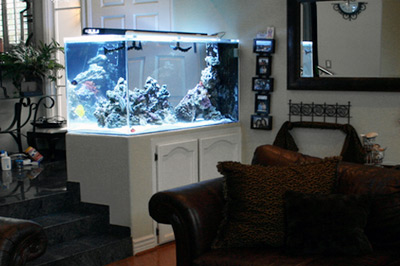To put a lid on it or not to put a lid on it, that is the question!
Okay, with profuse apologies to the Melancholy Dane, the point I’d like to mull over in today’s post is whether it’s a good idea to use cover glasses on marine aquariums—you know, those oft-hinged glass or acrylic lids that are available in various dimensions to fit tightly atop aquariums of different sizes.
As with so many aspects of the marine aquarium hobby, there’s no all-encompassing right or wrong answer to this question. Suffice it to say that cover glasses may be appropriate in some circumstances but totally inappropriate in others.
To determine what’s best for your system, consider these cover glass pros and cons:
Pros:
- Having a cover glass in place reduces evaporation, which in turn can reduce the size and frequency of freshwater top-offs and helps lower the humidity in the room housing the aquarium.
- Fish prone to jumping or slithering out of a tank are kept in the aquarium where they belong. Some fish, such as eels, and even certain invertebrates, such as octopuses, are such good escape artists that a tight-fitting lid is a must when keeping them. However, for many fish species, there are alternatives to glass/acrylic lids that may do the same job, e.g., covers made of some type of mesh or screening material or plastic egg crate.
- The light fixture is better protected from splashes and corrosive salt spray. This is especially important if the fixture isn’t equipped with protective lenses to shield the bulbs/tubes.
- Salt creep doesn’t advance as far with a cover glass in place, though it will still build up on the cover itself.
Cons:
- A cover glass can reduce vital gas exchange at the water surface (think of the interface between the water surface and the air above it as the system’s “lungs”). Having an open sump and providing vigorous protein skimming can help compensate for this.
- Lime deposits and salt creep on a glass/acrylic cover reduce light penetration, which is detrimental to photosynthetic invertebrates. So, regular cleaning of the cover glass (another maintenance task) is essential to prevent this buildup.
- A tight-fitting cover tends to trap heat, which can lead to unacceptably high water temperatures, especially in warmer seasons.
- Evaporation decreases. Yep, this can be a con as well as a pro because it also means there’s less evaporative cooling going on, further contributing to heat buildup. A slow rate of evaporation can also be a con for reefkeepers who drip kalkwasser to supplement calcium and alkalinity since saturated kalkwasser is typically used for freshwater top-offs.
What have I missed?
I’m sure I’ve overlooked some pros and/or cons to cover glass use. If you can think of any to add, please let us know in the comment section below.



